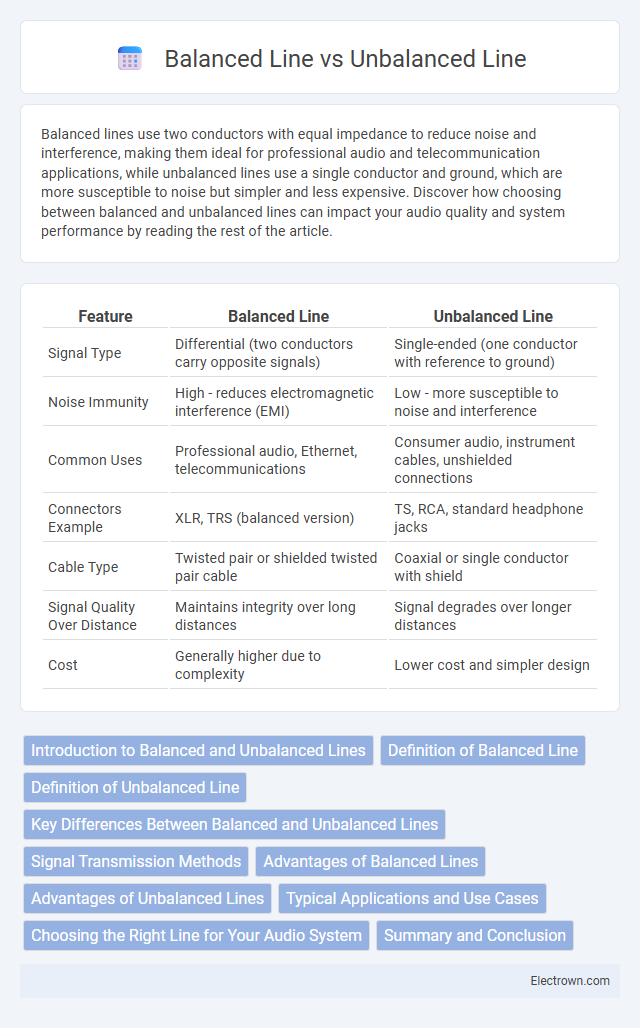Balanced lines use two conductors with equal impedance to reduce noise and interference, making them ideal for professional audio and telecommunication applications, while unbalanced lines use a single conductor and ground, which are more susceptible to noise but simpler and less expensive. Discover how choosing between balanced and unbalanced lines can impact your audio quality and system performance by reading the rest of the article.
Table of Comparison
| Feature | Balanced Line | Unbalanced Line |
|---|---|---|
| Signal Type | Differential (two conductors carry opposite signals) | Single-ended (one conductor with reference to ground) |
| Noise Immunity | High - reduces electromagnetic interference (EMI) | Low - more susceptible to noise and interference |
| Common Uses | Professional audio, Ethernet, telecommunications | Consumer audio, instrument cables, unshielded connections |
| Connectors Example | XLR, TRS (balanced version) | TS, RCA, standard headphone jacks |
| Cable Type | Twisted pair or shielded twisted pair cable | Coaxial or single conductor with shield |
| Signal Quality Over Distance | Maintains integrity over long distances | Signal degrades over longer distances |
| Cost | Generally higher due to complexity | Lower cost and simpler design |
Introduction to Balanced and Unbalanced Lines
Balanced lines use two conductors with equal impedance to ground, minimizing noise and interference, ideal for professional audio and telecommunications. Unbalanced lines consist of a single conductor and a shield, common in consumer audio equipment but more susceptible to noise over long distances. Your choice between balanced and unbalanced lines impacts signal quality and noise reduction in your audio or data transmission system.
Definition of Balanced Line
A balanced line consists of two conductors with equal impedance to ground and equal but opposite signals, which reduces noise and interference. This design is commonly used in professional audio, telecommunications, and data transmission to maintain signal integrity over long distances. Unlike unbalanced lines, balanced lines rely on differential signaling to cancel out external electromagnetic interference.
Definition of Unbalanced Line
An unbalanced line is a type of electrical transmission line where one conductor carries the signal, and the other is connected to the ground, creating an asymmetrical signal path. This configuration is commonly used in consumer audio and video equipment, such as RCA cables, due to its simplicity and lower cost. Your choice of an unbalanced line affects susceptibility to electromagnetic interference and signal degradation over longer distances.
Key Differences Between Balanced and Unbalanced Lines
Balanced lines use two signal conductors with equal impedance to ground, effectively reducing noise and electromagnetic interference, making them ideal for professional audio and long cable runs. Unbalanced lines consist of a single signal conductor with a ground reference, which are simpler and less expensive but more susceptible to noise, suitable for short-distance connections. Your choice depends on the audio environment and equipment sensitivity, where balanced lines ensure cleaner signals in demanding setups.
Signal Transmission Methods
Balanced line transmission uses two conductors with equal impedance to ground, carrying signals as equal and opposite voltages to minimize noise and electromagnetic interference. Unbalanced line transmission employs a single conductor with a ground reference, making it more susceptible to noise over long distances. Choosing balanced lines enhances your signal integrity and reduces interference in professional audio and communication systems.
Advantages of Balanced Lines
Balanced lines offer superior noise rejection and improved signal integrity by using two conductors with equal impedance, which minimizes electromagnetic interference (EMI) and crosstalk. These lines are ideal for long-distance audio and data transmission, ensuring clear and high-quality signal delivery in professional and studio environments. Your audio setup benefits from reduced hum and interference, providing a cleaner and more reliable sound experience.
Advantages of Unbalanced Lines
Unbalanced lines offer simplicity and cost-effectiveness, making them ideal for short-distance audio and signal transmission where interference is minimal. Their single conductor plus ground design allows easy implementation with common connectors like RCA and TS, which are widely compatible with consumer electronics. Despite susceptibility to noise over long runs, unbalanced lines excel in compact, straightforward setups requiring minimal shielding and installation complexity.
Typical Applications and Use Cases
Balanced lines are commonly used in professional audio and telecommunications settings, such as studio recordings, broadcast environments, and long cable runs, because they effectively reduce noise and electromagnetic interference. Unbalanced lines are typically found in consumer audio equipment, guitar cables, and short-distance connections where noise susceptibility is less critical. Your choice depends on the need for noise rejection and cable length, with balanced lines preferred for critical, high-quality signal transmission.
Choosing the Right Line for Your Audio System
Balanced lines use two signal conductors with opposite polarity and a ground, reducing noise and interference, making them ideal for professional audio and long cable runs. Unbalanced lines consist of a single conductor and ground, suitable for short distances and consumer electronics where noise is minimal. Choosing the right line for your audio system depends on cable length, environment, and the need for noise immunity to ensure optimal sound quality.
Summary and Conclusion
Balanced lines use two conductors with equal impedance to ground, minimizing noise and interference, making them ideal for professional audio and communication systems. Unbalanced lines have a single conductor and a ground reference, making them simpler but more susceptible to electromagnetic interference, commonly found in consumer electronics. Choosing between balanced and unbalanced lines depends on the noise environment and distance of signal transmission for optimal audio fidelity.
Balanced Line vs Unbalanced Line Infographic

 electrown.com
electrown.com